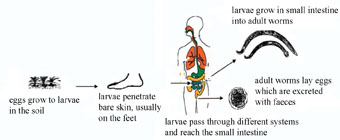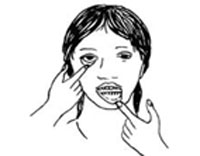34.2.2 Hookworm infection
Hookworm infection is transmitted via contact with faeces, but it is not actually a faeco-oral disease, because the infection does not enter through the mouth, as you will see below in our discussion of its transmission process. However, it is appropriate to discuss hookworm infection with other faeco-oral diseases because the infectious agents exit from the body in the faeces, the routine deworming regimen is the same as for ascariasis (Table 34.1 above), and prevention and control includes the measures already described for other faeco-oral diseases (see Study Sessions 32 and 33).
Hookworms live in the small intestine and suck blood from blood vessels in the intestinal walls. The main infectious agents are called Necator americanus and Ancylostoma duodenale. Hookworm infection is endemic in Ethiopia, especially in areas where people walk barefooted and sanitary conditions allow faeces to contaminate the soil. In Ethiopia the prevalence of hookworm infection is estimated to be around 16% of the population.
During the transmission process (Figure 34.6), immature parasites (larvae) in the soil enter the body by penetrating the skin, usually through bare feet. The larvae then migrate to the small intestine, after passing through different body systems. In the small intestine, the adult worms mate and the females lay eggs which are excreted with the faeces. The eggs develop in the soil into larvae, which can then be transmitted to new individuals through the skin.

What preventive measure should you advise people in your community to apply to protect themselves from hookworms?
In addition to all the measures involving personal hygiene after defaecation, before food preparation and when eating etc., you should specifically educate your community to interrupt the transmission of hookworms by:
- Wearing shoes to prevent the parasites from entering through skin while walking barefooted.
- Using latrines, disposing of faeces safely and stopping open defaecation in fields, to prevent contamination of soil with the parasites.
Diagnosis and treatment of hookworm infections
Cases of chronic hookworm infection manifest with abdominal pain and the symptoms and signs of anaemia (see Box 34.1), due to blood loss caused by the blood-sucking worms. It is very important that you treat worm infestations routinely in children aged from two to five years, because persistent hookworm infections (like ascariasis) causes a significant loss of micronutrients (minerals and vitamins) from the body. Infected individuals may develop anaemia, which can be life-threatening. Anaemic children fail to grow properly and their school performance will be negatively affected.
Box 34.1 Anaemia: a common sign of ascariasis or hookworm infection
Anaemia refers to a deficiency of haemoglobin in the blood. Haemoglobin is the red, iron-rich protein that gives red blood cells their colour and enables them to pick up oxygen and transport it around the body. Symptoms and signs of anaemia include becoming easily tired; pallor (paleness) inside the eyelids, gums, nails and palms of the hands (Figure 34.7); shortness of breath; and a fast pulse rate, which an anaemic person may notice as their heart beating fast even when they are quietly resting. Therefore, routine deworming of children aged between two to five years, every six months, according to the dosages given in Table 34.1 earlier, is essential to kill hookworms as well as ascaris worms.

In the next study session, we turn to the largest single cause of mortality among children under the age of five years: acute respiratory tract infections.
34.2.1 Ascariasis
